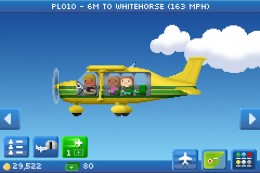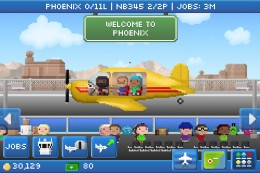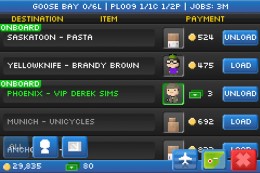![]() In an age where game studios are talking to behavioral psychologists and hiring retention experts and monetization specialists in a rush to juice the most out of free-to-player gamers, there’s at least one studio developing free-to-play games that doesn’t care about metrics, compulsion loops, and user acquisition. Game business never informs game design at NimbleBit. Fun is first, the mechanics of free-to-play are secondary.
In an age where game studios are talking to behavioral psychologists and hiring retention experts and monetization specialists in a rush to juice the most out of free-to-player gamers, there’s at least one studio developing free-to-play games that doesn’t care about metrics, compulsion loops, and user acquisition. Game business never informs game design at NimbleBit. Fun is first, the mechanics of free-to-play are secondary.
Pocket Planes is the next big thing from the two-man studio, and it’s philosophically linked with its other titles. Without shaking a virtual change cup in your face, Pocket Planes gives you a vibrant and customizable world and ownership over it as you ferry a fleet of planes from one airport to the next. Designers David and Ian Marsh believe that these components will be enough to organically drive the free-to-play aspect. No business trickery is required.
The Art Of Good Free-To-Play
 “[Our] philosophy is to consider monetization as little as possible during the design of the game," Ian tells TouchArcade. “The in-game currencies are balanced to be a natural part of the game without the option to even purchase more during design and beta," he points out. “Adding IAP and deciding how much to charge is always one of the last things we do before launch. We take care to make sure that everything in the game is accessible and achievable without every purchasing IAP."
“[Our] philosophy is to consider monetization as little as possible during the design of the game," Ian tells TouchArcade. “The in-game currencies are balanced to be a natural part of the game without the option to even purchase more during design and beta," he points out. “Adding IAP and deciding how much to charge is always one of the last things we do before launch. We take care to make sure that everything in the game is accessible and achievable without every purchasing IAP."
Ian and David proved that this approach works with Tiny Tower. The game made money even though monetization aspects weren’t a focal point. The game also did well with critics, earning all sorts of amazing reviews and even a Game of the Year nod in 2011 from the editorial team at Apple. Millions of people played Tiny Tower, too.
Pocket Planes is still deeply in beta, but I’m as hopelessly … hooked on it as I was Tiny Tower. Every ten or so minutes I pick up my phone and plan more flights. When I’m not playing, I spend time thinking about new planes and creative ways to expand my cash and transport flow. Should I grind in my current selection of airports until I can buy New York’s airport? Or should I keep expanding with much smaller airports to broaden my empire, and slowly build up the necessary resources to acquire international hubs? What if I converted all my fleet to four-seat airplanes? How much could I earn then?
 These are the questions running through my head, in part because the simulation aspect of the experience is so good. But I’m also just straight-up invested in the world that I’m creating, and I want to keep making it bigger and better. There are so many small, yet beautiful touches in Pocket Planes that drive my mania. I can name all my planes and customize each of my pilots. My passengers post their thoughts on an in-app Facebook client called “BitBook." I can buy any airport that I can afford, and I can also upgrade it to make it bigger and better. I can build my planes and when I watch them fly, I can collect the game’s two currencies randomly floating in the air. Pocket Planes also knows when I’m flying. The day and night cycle is synced to the real world. When I receive a Push notification, my phone emits a soft airplane cabin ding.
These are the questions running through my head, in part because the simulation aspect of the experience is so good. But I’m also just straight-up invested in the world that I’m creating, and I want to keep making it bigger and better. There are so many small, yet beautiful touches in Pocket Planes that drive my mania. I can name all my planes and customize each of my pilots. My passengers post their thoughts on an in-app Facebook client called “BitBook." I can buy any airport that I can afford, and I can also upgrade it to make it bigger and better. I can build my planes and when I watch them fly, I can collect the game’s two currencies randomly floating in the air. Pocket Planes also knows when I’m flying. The day and night cycle is synced to the real world. When I receive a Push notification, my phone emits a soft airplane cabin ding.
These are the aspects that David and Ian believe drive users to spend. These are the things it spends all of its time developing. There is no conversation about loops or feedback. The duo spend their time making games with character, real progression, and meaningful stuff. Their games have a soul.
“I’m not sure if there is some kind of secret sauce, but we definitely focus a lot of time on adding lots of things to our simulation games that make them feel like a functional little world inside," David tells us. “I think the stronger the feeling that there is a buzzing simulation going on inside the game, the more fun it is to influence it and use your actions to mould and direct it."
“I agree with Dave completely," Ian says. “The more detail and emotion you put into these little worlds the more immersed players become and the more they enjoy spending time with it."
“I think the customization has a lot to do with it as well," he continues. “That isn’t just a plane flying in the game, it is your plane that you named yourself and spent time finding the perfect paint job for. In Tiny Tower, it isn’t just a generic bakery, it’s Brad’s Bread with interior decoration of his choosing and hand picked employees that took work for him to recruit."
David explains that Tiny Tower and the feedback blowing up NimbleBit’s inbox is actively informing the development of Pocket Planes. Users are lauding their game design ideals and are actually thanking David and Ian for making a fun game first.
 “I think we definitely are trying to strike the same balance and attitude in all our future free-to-play games because it resonates with players and matches the type of games we prefer to play ourselves," David says. “The other thing we have learned from Tiny Tower and also Pocket Frogs is that the more we can stimulate players imaginations the better. The kind of fan art and fan communities that have grown around those games is amazing and that is a target we are always aiming for."
“I think we definitely are trying to strike the same balance and attitude in all our future free-to-play games because it resonates with players and matches the type of games we prefer to play ourselves," David says. “The other thing we have learned from Tiny Tower and also Pocket Frogs is that the more we can stimulate players imaginations the better. The kind of fan art and fan communities that have grown around those games is amazing and that is a target we are always aiming for."
Pocket Planes is shaping up to be a tremendous game and my praise is coming at a time when more and more new free-to-play games continue to feel like skinner boxes instead of fun things to play with. Ian and David are doing important work here, proving that free-to-play doesn’t need to inform fundamental game design.
“Even without spending a dime, players become heavily invested in these worlds because of their character and charm — not some carefully crafted compulsion loop. That is what keeps them coming back," Ian says.
Fun doesn’t need to cost a penny, and that’s what NimbleBit strives to make a reality with each release.
